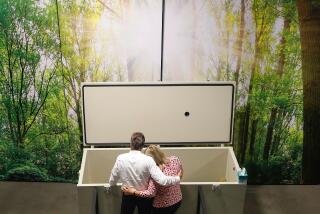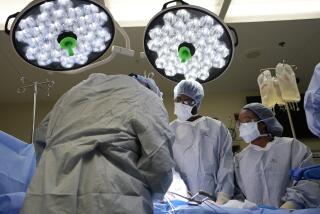Heartfelt Thanks for Gift of Life : Personal health: Organ recipient Irene Furlong wants people to know that transplants work and that more donations are needed.
The Museum of Science and Industry in Los Angeles recently had an unusual exhibit: Irene Furlong.
Surrounded by organ transplantation displays, the 47-year-old businesswoman and mother sat behind a booth at the museum and greeted visitors in her direct, no-nonsense manner.
“I’d shake their hands and say ‘Hi. I’m Irene Furlong. I had a heart transplant. I’m here to show you it works.’ And they would take a donor card and sign it.”
Furlong smiles. She has regained her health, thanks to the transplant at UCLA almost four years ago. Now she works to see that others with similar needs have the chance for the same results.
And in a society apparently uncommitted to organ donation, she is a valuable and persuasive messenger.
“Transplant recipients are an incredible voice,” says Barbara Schulman, senior transplant coordinator for the Regional Organ Procurement Agency at UCLA. “It’s the idea that if you could see that transplantation works, the general public would be motivated to donate.”
Furlong puts it this way: “I think we don’t have enough organs because people aren’t educated about the need. We have a slogan: ‘Don’t take your organs to heaven; we need them here.’ ”
Today Furlong will join a group of recipients, donor families and transplantation health-care workers at a White House reception hosted by First Lady Barbara Bush to promote organ and tissue donation.
Organizers hope the event communicates the need for donated organs. But statistics show their task is a difficult one.
After slow but steady donation increases during the 1980s, the numbers apparently have flattened out at about 4,000 in each of the last three years, according to the United Network for Organ Sharing.
Besides a decrease in deaths caused by automobile accidents, officials say organ donations have not increased because many hospitals have not developed successful methods of requesting donations from grieving families. And some people fear that a loved one’s death will be hastened if they agree to donate organs, that the organs will be sold or that the body will be damaged during removal.
Still, the need for transplants continues to increase. In 1990, more than 20,000 Americans were on waiting lists to receive an organ: kidney, liver, pancreas, heart, lung or a heart-lung combination. Because of the shortage of available organs, about 30% die before getting a transplant.
For those who do obtain a transplant, the outlook has never been better. Most transplant recipients now survive the first crucial year, and the majority live five years or more. Better medications preventing organ rejection have contributed enormously to success rates, and most recipients go on to normal lives.
Furlong’s life before her transplant was anything but normal.
It was determined when she was 15 that she had an ailment that caused a rapid abnormal heartbeat. The West Los Angeles woman was taking stabilizing medication by age 20. At 30, married and the mother of two children, she had her first heart attack.
Between that attack and her transplant 13 years later, Furlong was resuscitated 27 times--often by family members who kept a defibrillator, a device that delivers an electric shock to restart the heart or regulate heartbeat, at home. She learned biofeedback, and when she felt her heart failing--she calls it “going sour”--she would call paramedics, then put herself in a deep meditative trance to slow her breathing and heart rate until help arrived.
When she was 43, Furlong was told by her doctor that her heart muscles had deteriorated so badly she would need a transplant.
“I remember telling my mother, ‘I don’t need one. Let’s get out of here,’ ” she says. “I felt like I could be fibrillated (sic) for the rest of my life.”
But an evaluation a few weeks later convinced Furlong that a transplant was her only hope. She was told she was 10th on the waiting list.
“When they said I was 10th, I got very nervous,” she says.
Within hours, however, two things happened: Furlong’s heart started to fail again and someone from UCLA called to say a potential donor had been found for her. Less than 24 hours after she was placed on the waiting list, Furlong received the heart of a 12-year-old boy who had died in an accident.
Because the heart was from a child, it was too small for several men ahead of Furlong on the waiting list. Other factors, like blood and tissue types, also go into matching a donor heart and recipient.
As often is the case for transplant recipients, Furlong’s recovery was difficult. Medications caused her face, abdomen and back to swell, and weakened leg muscles left her unable to walk. She sometimes trembled so violently that her mother, Sylvia Kantor, lay on her in her hospital bed to calm her. During the first year, Furlong’s body tried to reject the new heart, but doctors treated the rejection with strong medication. Her husband, Conrad, and children, Aaron and Annette, kept her spirits up.
“We pretended it was no big deal,” she says.
After about a year, Furlong’s body shrank to normal size, her energy returned, her skin glowed with good health. And she got busy trying to help others who were going through transplants or waiting for a precious organ.
She co-founded the Los Angeles chapter of Transplant Recipients International Organization, a support group for recipients and their families. She also serves on TRIO’s international board.
“Before my transplant, I gave nothing to this world,” she says, in her crisp, assured style. “I just went to work and stayed home. Now I am so well, I must give back.”
Furlong also sits on a committee at the Regional Organ Procurement Agency that discusses issues like organ allocation and the use of new medications in transplantation. The group’s most pressing problem is increasing donors.
Only about 20,000 U.S. deaths each year (about 1% of all deaths) occur under conditions that would allow retrieval of donor organs.
An organ donor must be declared brain-dead (the total and irreversible cessation of all functions of the brain and brain stem) by at least two physicians, and the organs must be in good condition.
Experts offer various opinions why organ donations have not met expectations and what might be done. Seat belts, air bags and motorcycle and bicycle helmets have reduced accidental deaths, but there are other factors.
All U.S. hospitals must have procedures for asking family members to donate organs in cases of brain death. But the success of federal and state “required request” laws passed in the 1980s, which were designed to increase organ donations by requiring the protocols, has been questionable.
Generally, hospitals face no consequences for noncompliance, Schulman says.
Further, she adds: “It isn’t quite clear who within a hospital should do it. The nurse, the physician, the administrator. The law says you should have a protocol. Some people get a protocol, put it somewhere and don’t know where it is. No one is keeping track in terms of how many deaths and how many people have been referred.
“We know there is a big gap in Los Angeles between the number of deaths and the number of referrals we get. I feel not all the potential donors are being referred.”
And organ donations could be increased as much as 50% if hospitals adopted a more sensitive request protocol, according to members of the Partnership for Organ Donation Inc., a private, nonprofit organization founded to increase donations.
Based on a recent study of organ procurement efforts in Kentucky, the organization found that although public opinion polls show that 84% of Americans support organ donation, more than half of the families approached for donation said no. The study attributed this to inappropriate request methods. For example, families were asked in public places or were asked before they fully understood and accepted that cessation of brain function is the same as death.
The study found that 87% of neurosurgeons say they request donation before or at the same time they inform the family of the death. According to the study, it is far better to allow the family some time to accept the death before seeking organ donation.
Although sensitively asking a family is one step toward permission, it won’t guarantee a donation. Sometimes, family members can’t agree.
“Sometimes you have 20 people at the bedside,” Schulman says.
In addition, the emotional conditions surrounding sudden, unexpected deaths are often not conducive to obtaining permission.
“We see a lot of shootings in this area. But there is so much anger and hostility, it’s very difficult to listen to someone who comes to you and asks you to do something nice for someone else,” Schulman says.
Some people are concerned that organs go only to the rich and that they would never benefit in return. Families also may be concerned that the body will be mutilated during retrieval of the organs or fear someone will profit from the donation.
And, says Dr. Hillel Laks, director of the heart and lung transplant programs at UCLA: “There are some concerns that if they give permission, maximum efforts to save (the patient) would not happen. They don’t understand that the family is only asked when there is already brain death.”
The most conducive circumstances to donation are when family members have verbally discussed donation beforehand and when it is specified in a living will.
“If someone has not thought about it before it actually happens, they are not likely to go ahead and give consent,” he says.
Finally, some people may not understand just what they are giving by agreeing to donate organs. That’s where people like Furlong come in. Healthy, active transplant recipients remain the best advertisement.
“Studies indicate that the one thing that really impacts on the public in making donations is having known a recipient or having spoken to a recipient,” says Veronica Eeury, executive director of the Pittsburgh-based TRIO. “It is something people remember. It touches them in some way.”
Transplant recipients aren’t sickly people who live day-to-day, Furlong says.
“I would say that, after the first year, we’re normal people,” she says. “We’re very vital. Look at me. I’m a Type-A person.”
So she’ll keep urging people she meets not to take their organs to heaven:
“We think by educating the public, people someday will go up to hospital personnel and say ‘My husband is brain-dead, can his organs be transplanted?’ ”
DONOR SHORTAGE
The number of people needing organ transplants continues to rise but the availability of donor organs has not kept pace.
Number Waiting Donors (approx.) Died Waiting 1988: 14,332 4,000 1,616 1989: 16,966 4,000 1,878 1990: 20,177 4,000 2,000 (approx.)
Source: United Network for Organ Sharing
More to Read
Sign up for Essential California
The most important California stories and recommendations in your inbox every morning.
You may occasionally receive promotional content from the Los Angeles Times.










